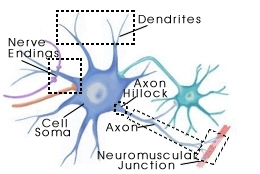What part of a neuron is most similar to the other cells in your body?
Affiliate 8: System of Cell Types
8.1 Introduction to Neurons and Glial Cells
The human nervous system is estimated to consist of roughly 360 billion non-neural glial cells and 90 billion nerve cells. Furthermore, there are hundreds of unlike types of neurons based on morphology lone. Often, neurons that look like have strikingly different properties. For case, they utilize and reply to different neurotransmitter(s). This department reviews the cellular components of nervous tissue. Students should be able to draw neurons and glia, their morphological components as seen with the lite and electron microscope, and some of the fundamental functional roles these cell types play in the nervous system.
8.2 Model Neuron
| |
| Figure viii.ane |
Subsequently reviewing the Model Neuron to a higher place, learn more about the function of each construction past tapping from the list below.
- Cell Soma
- Dendrite
- Initial Segment and Axon Hillock
- Axon
- Nerve Endings
- Neuromuscular Junction
8.iii Cell Soma
 Click the identified structures on the model neuron to movement to the related section.
Click the identified structures on the model neuron to movement to the related section.
The region of the neuron containing the nucleus is known equally the cell body, soma, or perikaryon (Effigy 8.2). The jail cell body is the metabolic center of the neuron.
The interior of the soma consists of cytoplasm, a gel inside a microtrabecular lattice formed by the microtubules and associated proteins that make upward the cytoskeleton.
Energy producing metabolism and the synthesis of the macromolecules used by the cell to maintain its structure and execute its office are the principal activities of the neuronal soma. As described in Chapter 6, information technology also acts as a receptive area for synaptic inputs from other cells. Embedded inside the neuronal cytoplasm are the organelles common to other cells, the nucleus, nucleolus, endoplasmic reticulum, Golgi appliance, mitochondria, ribosomes, lysosomes, endosomes, and peroxisomes. Many of these cell inclusions are responsible for the expression of genetic information decision-making the synthesis of cellular proteins involved in energy product, growth, and replacement of materials lost by attrition.
| |
|
|
